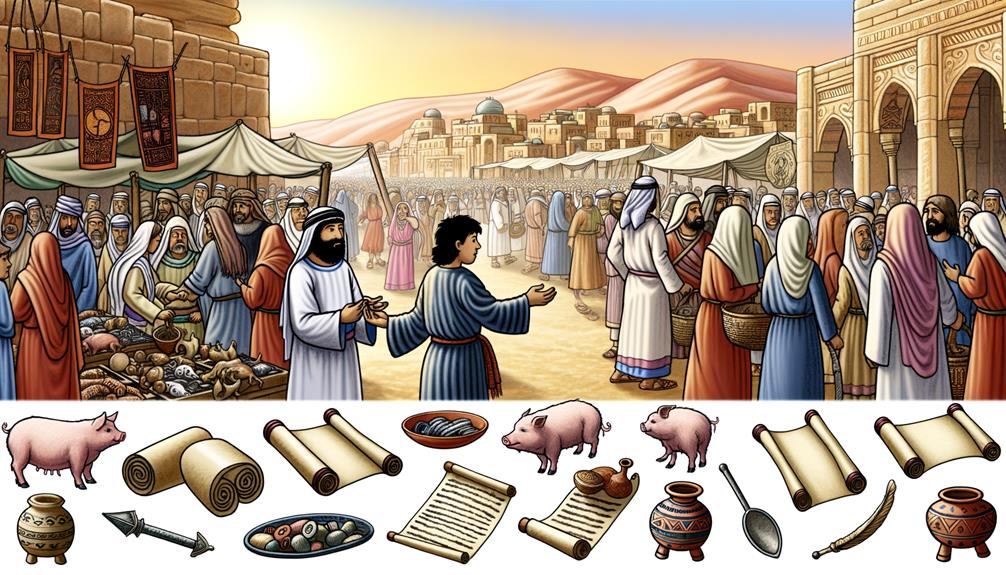Swine Meaning in the Bible: Unclean Animals Symbolism
In the Bible, swine are depicted as symbols of ritual impurity and moral degradation. Leviticus 11:7-8 categorizes them as unclean, prohibiting their consumption to maintain spiritual sanctity and Israel’s covenantal identity.
Swine further symbolize folly and lack of discernment, as highlighted in Proverbs 11:22. Jesus’s act of casting demons into pigs illustrates their association with demonic forces and moral corruption.
In the parable of the Prodigal Son, feeding swine underscores spiritual degradation but also hints at the potential for redemption through divine grace. Understanding these contexts deepens the appreciation of their theological significance.

Swine Meaning in the Bible: Symbol of Uncleanliness and Spiritual Warning
| Biblical Reference | Meaning | Symbolism | Spiritual Insight |
|---|---|---|---|
| Leviticus 11:7 | Unclean Animal | Swine deemed unclean by the Law | Emphasizes holiness through dietary laws |
| Matthew 7:6 | Misuse of Sacred Things | Pearls before swine | Warning not to offer holy things to the unworthy |
| Luke 15:15-16 | Rock Bottom in Sin | Prodigal Son feeding pigs | Represents spiritual emptiness and repentance |
| Isaiah 65:4 | Rebellion and Defilement | Eating swine’s flesh | Symbol of disobedience and moral corruption |
| 2 Peter 2:22 | Returning to Sin | Swine wallowing in mire | A warning against turning back to old sins |
Swine in Leviticus

In the book of Leviticus, swine are explicitly classified as unclean animals, forbidden for consumption by the Israelites. Leviticus 11:7-8 states that, although swine have cloven hooves, they do not chew the cud and are thus deemed unclean.
The prohibition underscores a broader theological framework where dietary laws symbolized Israel’s distinctiveness and holiness. Historically, these laws functioned to separate the Israelites from neighboring cultures and their practices.
Scriptural analysis reveals that such regulations were integral to maintaining ritual purity, reflecting deeper spiritual principles about obedience and identity. Consequently, the classification of swine as unclean underscores a divine mandate for the Israelites to adhere to God’s covenantal stipulations and remain consecrated to Him.
Unclean Animals

Among the various classifications within Levitical law, unclean animals are meticulously enumerated to delineate those creatures that the Israelites must avoid to maintain ritual purity and obedience to divine commandments.
The Book of Leviticus outlines specific criteria for these designations, emphasizing the importance of dietary regulations in sustaining spiritual sanctity. The following table provides a concise categorization of unclean animals:
| Category | Examples |
|---|---|
| Land Animals | Swine, camel, rabbit |
| Sea Creatures | Lobster, shrimp, catfish |
| Birds | Vulture, owl, raven |
| Insects | Beetle, fly, ant |
| Reptiles/Amphibians | Lizard, frog, snake |
These prohibitions underscore a broader theological principle: the pursuit of holiness through everyday practices, reflecting deeper covenantal relationships between the Israelites and God.
Swine in Proverbs

In the book of Proverbs, swine serve as a potent symbol of foolishness, often contrasted with the virtues of wisdom and discernment.
Proverbs 11:22, for instance, likens a beautiful woman without discretion to a gold ring in a pig’s snout, highlighting the incongruity and moral implications of external beauty devoid of inner wisdom.
This comparison underscores the biblical perspective that true value lies in moral integrity rather than superficial appearances.
Symbol of Foolishness
Proverbs vividly employs the image of swine to represent the folly and lack of discernment inherent in foolish behavior. In Proverbs 11:22, for instance, ‘Like a gold ring in a pig’s snout is a beautiful woman who shows no discretion,’ the swine symbolizes the absurdity of placing valuable attributes in an unworthy context.
Historically, swine were viewed as unclean animals within Jewish culture, amplifying their use in Proverbs as symbols of impurity and irrationality.
Scripturally, this metaphor elucidates the incongruity between outward beauty or potential and inner foolishness. The use of swine in Proverbs underscores the Biblical admonition against ignoring wisdom and discernment, highlighting the moral and spiritual pitfalls of foolishness.
Contrast With Wisdom
The juxtaposition of swine with wisdom in the book of Proverbs serves to accentuate the disparity between foolishness and the pursuit of a discerning, righteous life.
Proverbs 11:22 poignantly states, ‘Like a gold ring in a pig’s snout is a beautiful woman who shows no discretion.’ This metaphor employs the swine, an animal considered unclean in ancient Israelite culture, to highlight the incongruity of external beauty devoid of inner wisdom.
Historically, the Israelites viewed pigs as symbols of impurity, thereby reinforcing that wisdom and discernment are paramount over superficial attributes.
Such scriptural comparisons underscore the Biblical emphasis on cultivating an internal, godly wisdom that transcends mere outward appearance and societal status.
Moral Implications
Exploring the moral implications of swine imagery in Proverbs reveals profound insights into the Biblical understanding of purity, wisdom, and ethical conduct.
Proverbs 11:22 states, ‘Like a gold ring in a pig’s snout is a beautiful woman who shows no discretion.’ This vivid metaphor underscores the value of inner virtue over external beauty.
Historically, swine were considered unclean animals in Jewish culture (Leviticus 11:7), symbolizing moral and spiritual impurity. By employing this imagery, Proverbs emphasizes the importance of discernment and integrity.
The underlying message is clear: true wisdom and righteousness surpass superficial attributes, urging believers to cultivate ethical behavior and spiritual purity.
Such teachings remain relevant, encouraging a life of moral excellence and thoughtful judgment.
Demons and Swine

In the New Covenant, the association of demons with swine is most prominently illustrated in the account of Jesus casting out a legion of demons into a herd of pigs, as recorded in the Synoptic Gospels.
This event, found in Matthew 8:28-34, Mark 5:1-20, and Luke 8:26-39, underscores the profound spiritual authority of Jesus. The narrative not only highlights the destructive nature of demonic forces but also the symbolic impurity linked to swine in Jewish culture.
The pigs’ subsequent rush into the sea, resulting in their demise, serves as a stark visual metaphor for the ultimate fate of evil. This passage invites theological reflection on the power of divine intervention and the liberation from spiritual bondage.
The Prodigal Son

Within the narrative of the Prodigal Son, Jesus masterfully employs parable to illustrate themes of repentance, forgiveness, and divine grace, as recounted in Luke 15:11-32.
The younger son’s descent into destitution, marked by his employment feeding swine—a ceremonially unclean animal in Jewish culture—symbolizes profound spiritual degradation.
His eventual repentance and return to the father’s house signify the transformative power of humility and contrition.
The father’s joyous reception, which includes a celebratory feast, underscores the boundless mercy and unconditional love of God.
Through this parable, Jesus communicates the profound theological message that no matter the depth of one’s fall, divine grace offers a path to redemption, emphasizing God’s readiness to forgive and restore those who turn back to Him.
Cultural Context

To fully appreciate the significance of swine in biblical texts, one must consider the broader cultural and religious context of ancient Jewish society, where these animals were deemed ritually impure. The aversion to swine is deeply rooted in the social norms and religious practices of the time.
Swine symbolized not only physical uncleanness but also moral and spiritual defilement. Understanding this context is essential for interpreting scriptural references to swine, whether in parables or laws.
| Cultural Aspect | Significance | Scriptural Reference |
|---|---|---|
| Ritual Purity | Swine deemed impure | Leviticus 11:7-8 |
| Social Norms | Avoidance of swine | Isaiah 65:4 |
| Moral Implications | Symbol of defilement | Matthew 7:6 |
| Religious Practices | Dietary restrictions | Deuteronomy 14:8 |
This context elucidates the profound symbolism attached to swine in biblical narratives.
Dietary Laws

In the context of biblical dietary laws, the distinction between clean and unclean animals, such as the prohibition against consuming swine, holds both health and spiritual significance.
Levitical texts, particularly Leviticus 11 and Deuteronomy 14, outline these dietary restrictions, emphasizing the covenantal relationship between God and the Israelites.
This demarcation serves not only to promote physical well-being but also to underscore ritual purity and obedience to divine commandments.
Clean Vs. Unclean Animals
The distinction between clean and unclean animals, as delineated in the dietary laws of Leviticus 11 and Deuteronomy 14, reflects a complex interplay of theological symbolism and ancient Israelite cultural practices.
These classifications not only governed daily life but also symbolized the Israelites’ covenantal relationship with God.
Clean animals, such as cattle and sheep, were permissible for consumption and sacrificial offerings, signifying purity and holiness.
In contrast, unclean animals, including swine, were forbidden, representing impurity and separation from the divine.
This delineation underscored a theological framework where adherence to dietary laws became an act of obedience and worship, demarcating the Israelite identity and fostering communal sanctity within the broader narrative of their faith journey.
Health and Spiritual Significance
Beyond the symbolic implications, the dietary laws outlined in Leviticus and Deuteronomy also reflect profound considerations for both health and spiritual well-being.
The distinction between clean and unclean animals, such as the prohibition against consuming swine, is deeply rooted in ancient Israelite culture and theology.
From a health perspective, swine were known to carry diseases and parasites, posing significant risks.
Spiritually, adhering to these dietary laws signified obedience and consecration to God’s covenant.
Leviticus 11:7-8 and Deuteronomy 14:8 emphasize that abstaining from unclean animals was integral to maintaining ritual purity.
This dual emphasis on physical health and spiritual devotion underscores the holistic nature of biblical laws, aiming to foster a community aligned with divine intentions.
Symbolism of Impurity

Throughout biblical scripture, swine frequently symbolize ritual impurity and moral corruption. In Leviticus 11:7, pigs are deemed unclean because they do not chew cud, rendering them unfit for consumption by the Israelites. This prohibition underscores the broader theological principle of holiness and separation from defilement.
In addition, in Matthew 7:6, Jesus warns against casting ‘pearls before swine,’ implying that sacred truths should not be degraded by association with the impure. Historically, swine were emblematic of Gentile practices, contrasting starkly with Jewish dietary laws.
Consequently, the scriptural depiction of swine serves as a potent symbol of spiritual degradation, urging adherence to divine commandments and the pursuit of purity in both ritual and moral dimensions.
Modern Interpretations

In contemporary theological discourse, interpretations of swine in biblical texts often extend beyond ancient ritualistic connotations to explore their relevance in modern ethical and spiritual contexts. Scholars and theologians examine how these references inform current faith practices and moral decision-making.
This broader perspective can be illustrated through several key areas:
- Ethical Living: Understanding swine as symbols of impurity can inspire believers to pursue moral purity in modern life.
- Dietary Choices: Some faith communities continue to observe dietary restrictions, reflecting historical prohibitions.
- Spiritual Discernment: Swine imagery encourages individuals to avoid what is spiritually unclean or detrimental.
These interpretations enrich the contemporary understanding of biblical texts.
Conclusion
In sum, the biblical references to swine serve as powerful symbols of impurity, uncleanliness, and moral degradation.
From Leviticus’ dietary laws to Proverbs’ wisdom literature, swine are consistently portrayed in a negative light.
From the casting out of demons to the parable of the Prodigal Son, these references highlight the negative connotations associated with swine.
Understanding these references within their historical and cultural contexts underscores their theological significance, while modern interpretations continue to reflect on these enduring symbols of spiritual and ritual impurity.






